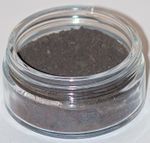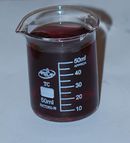Potassium ferrate
| |||
| Names | |||
|---|---|---|---|
| IUPAC name
Potassium ferrate
| |||
| Systematic IUPAC name
Potassium ferrate (VI) | |||
| Properties | |||
| K2FeO4 | |||
| Molar mass | 198.04 | ||
| Appearance | Dark purple crystals | ||
| Odor | Odorless | ||
| Density | 2.829 g/cm3 | ||
| Melting point | 198 °C (388 °F; 471 K) (decomposes) | ||
| Boiling point | Decomposes | ||
| Soluble (slowly decomposes unless pH is high) | |||
| Solubility in [[ethanol]] | Insoluble (0 °C and below) Reacts with solvent (20 °C) | ||
| Vapor pressure | ~ 0 mmHg | ||
| Hazards | |||
| Safety data sheet | Sigma-Aldrich | ||
| Flash point | Non-flammable | ||
| Related compounds | |||
| Related ferrate
|
Barium ferrate Sodium ferrate | ||
| Except where otherwise noted, data are given for materials in their standard state (at 25 °C [77 °F], 100 kPa). | |||
| Infobox references | |||
Potassium ferrate is a compound with a formula of K2FeO4. This is an unstable potassium salt of ferric acid, which itself is too unstable to exist in aqueous solution. It is a dark purple crystalline solid that dissolves to form a reddish-purple solution. This solution is stable at high pH, but at neutral or lower pH, the ferrate decomposes, liberating oxygen.
Potassium ferrate is a very strong, but relatively mild oxidizer.
Contents
Properties
Physical
It is a dark purple crystalline solid that dissolves to form a reddish-purple solution which tends to "fizz" if hot and/or not pure enough. Depending on the concentration, it could appear cherry-red, purple or almost black. Its solubility in water is limited, which makes potassium ferrate the most practical ferrate: it is soluble in water, unlike the insoluble barium ferrate, but relatively easy to crystallize out of the solution, unlike the very soluble sodium ferrate which is particularly hard to isolate as a solid salt.
Chemical
It is a very potent oxidizer. It oxidizes primary alcohols to carboxylic acids, carboxylic acids to carbon dioxide and water, chlorates to perchlorates, ammonia to nitrogen, nitrites and nitrates. It is not known whether it is capable of oxidizing bromate to perbromate.
At high pH, the oxidizing strength of ferrate is relatively low, and the ferrate itself can be prepared with weaker oxidizers such as hypochlorites and bromine. At low pH, the full oxidizing power of ferrate is revealed.
Ferric acid, of which it is a salt, is a mid-strength acid, between hydrofluoric and formic in pKa. However, since it immediately decomposes on formation, any acidic compound, including carbon dioxide in the air, displaces ferric acid from its salt according to Le Chatelier's principle. Thus, potassium ferrate, itself a slightly basic compound, reacts with all acids, evolving oxygen and precipitating iron (III) oxide or hydroxide. Reactions in solution with strong acids like sulfuric acid are very vigorous, ferrate decomposes with much heat, and oxygen evolves in a quick "sneeze" that may result in spraying and splattering of the solution. If stabilizing alkali (KOH) is also present in solution, its neutralization further adds to the exothermicity of the reaction.
Potassium ferrate slowly decomposes in water, slower if it's cold and more alkaline and the ferrate is of higher grade, faster if it's hot and more acidic, and the ferrate is of lower grade. The solution evolves oxygen, which gives it the characteristic "ferrate fizz".
Availability
There is a growing market for potassium ferrate as a practical and ecologically friendly water purificant. As such, it can be bought from certain companies. However, many suppliers of ferrate-based purificants from China and India offer tablets with low percentage of the active ingredient, rather than the salt that qualifies for any proper chemical grade. Pure potassium ferrate is sometimes offered by Sigma-Aldritch.
Preparation
There are several methods of ferrate synthesis. The most practical are the electrolytic method and the hypochlorite method. In the electrolytic method, a solution of potassium hydroxide is electrolyzed with iron electrodes. In the hypochlorite method, hydroxide or salts of trivalent iron are oxidized with hypochlorites in solution. Here is an example reaction:
- 2 Fe(OH)3 + 3 NaOCl + 4 KOH → 2 K2FeO4 + 3 NaCl + 5 H2O
In this method, a goop of freshly prepared iron (III) hydroxide is dissolved in a mixture of sodium hypochlorite and potassium hydroxide, with KOH in a large excess. The suspension quickly turns from brown to dark reddish-purple and clears out a bit, with the resulting ferrate dissolving, and the "fizz" appears. Note that in this method, side reactions also take place and lead to formation of potassium chlorate (Berthollet's salt). This phenomenon may be considered beneficial, given that potassium chlorate is also a useful and interesting oxidizer.
In any case, preparing a solution of potassium ferrate isn't very hard, but crystallization of the stable pure salt is. It cannot be crystallized by evaporating the solution, because this provokes it to decompose, but it can be displaced from the solution by adding excess KOH. The trick is to quickly crystallize the ferrate, filter, dissolve in a weak solution of potassium hydroxide, recrystallize by adding a lot more hydroxide, filter and dry very quickly, because the impure compound decomposes on the fly. Vacuum filtering through sintered glass is mandatory, because ferrate oxidizes filter paper (a makeshift filter made of calcined mineral wool, micropunctured polyethylene or a similar oxidation-resistant material can be used instead). Ice-cold anhydrous ethanol or diethyl ether is recommended for washing the crystals.
If you suspect the presence of Berthollet's salt as a side product, the second solution (of the crude ferrate in weak KOH) should be cooled to ice-cold temperature. This will cause chlorate to crystallize, in which state it can be recovered easily. It may come out yellow or brown, because of the decomposition products of ferrate; in this case, recrystallize potassium chlorate. Then recrystallize potassium ferrate as usual, by adding excess KOH.
Before you experiment with this salt, stock up on KOH! All methods of ferrate synthesis tend to gobble this alkali like popcorn. Regenerating potassium hydroxide after synthesis and recrystallizing of potassium ferrate is also a good idea. Also stock up on sintered glass filters: one is ruined after several filtrations of such a monstruously alkaline solution and not good anymore.
You should also remember that the worst enemy of ferrate synthesis is heat. A common mistake during this synthesis is adding dry KOH into the solution, which leads to the solution overheating and the ferrate decomposing as soon as it's formed. Because of this, you get catalytic decomposition of hypochlorite instead of ferrate synthesis. You should prepare a saturated solution of KOH beforehand and chill it below room temperature if you want any detectable yield!
The "ferrate volcano"
The colloquialism "ferrate volcano" describes several methods of synthesizing ferrates anhydrously using high temperature fusing with various oxidizers. The most common "ferrate volcano" is a reaction between potassium nitrate (or chlorate), potassium hydroxide and iron (III) oxide or metallic iron powder; the mixture reacts when set on fire, and the resulting molten slag contains potassium ferrate. The resulting slag, though, contains too few potassium ferrate to be useful.
There is a Russian patent of 2008 which describes an improved procedure, which is claimed to produce technical grade potassium ferrate with concentration of the pure salt up to 88% [1]. The ingredients are iron (III) oxide, metallic iron, carbon and potassium superoxide. Proportions are the following:
- 320 g of iron (III) oxide;
- 19.8 g of powdered metallic iron;
- 29.8 g of powdered amorphous carbon;
- 653.2 g of potassium superoxide.
The ingredients are mixed thoroughly, pressed into a tablet and heated until an exothermic reaction starts. The resulting slag is claimed to be technical grade potassium ferrate with a concentration of 80-88%, which is then to be ground and packaged in airtight containers for storage, or recrystallized using the techniques described above.
Handling
Safety
Potassium ferrate is non-toxic. The products of its decomposition aren't toxic either. However, dry potassium ferrate should not come in contact with flammable organic compounds. There were reports of warm ethanol catching fire on contact with potassium ferrate.
Storage
Potassium ferrate should be stored in a dark place, without access to air (it reacts with carbon dioxide in the air). Ideally, it should be kept under vacuum or inert gas. If you intend to store potassium ferrate, it is not recommended to wash it thoroughly from potassium hydroxide, because the alkali works as a stabilizer, scrubbing the air in the container from the destructive carbon dioxide and water and greatly increasing the ferrate's shelf life.
Disposal
Potassium ferrate solutions can just be poured into the ground or drain. Contact with any organics causes the ferrate to be quickly reduced and decomposed.

